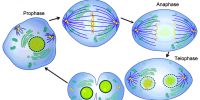On the basis of Nuclear Structure
Prokaryotic cell or Protocell: Nucleus is not well organized in these cells; nuclear membrane and nucleolus are absent here. In these cells, Chromosome contains only DNA. Generally, no other organelles are present except Ribosome. Cell division happens here through Amitosis process.
Eukaryotic cell or Eucell: There is the well-organised nucleus in these cells with membrane and nucleolus. The chromosome contains DNA, proteins Chloroplasts, Mitochondria and other organelles. Cell division happens through mitosis process.
On the basis of Function Somatic cell: These cells construct the living body but do not take part in reproduction. In the lower group of living objects they are haploid i.e. only one set of chromosomes are present, but in higher groups they are diploid i.e. there are two sets of the chromosome in the nucleus.
Reproductive cell: These cells take part in sexual reproduction but do not construct the main body. These cells are also haploid. Sperm and ovum are examples of the reproductive cell.
Size, shape and Structure of Living cell: It is normal to have some diversity in size, shape and structure of cells. The size, shape and structure of a eukaryotic cell (eucell) are described below in brief.
Size: A cell may be 0.1 it (micron) to 55cm (centimeter) or even more.
[1 Millimeter = 1000 Micron]
Shape: Cells are of different shapes. Mainly they are spherical, oval, rectangular, barrel-shaped or polygonal.














